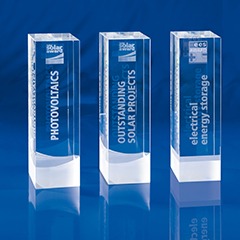Munich, May 19, 2016 – Complete with a new category and record number of submissions, this year’s Intersolar AWARD pays tribute to ground-breaking innovations in the solar industry for the ninth time in a row. Joining the established Photovoltaics category is the category entitled Outstanding Solar Projects, which will this year make its debut on a global level. The new category recognizes outstanding projects from around the world that make an exceptional contribution to driving forward the solar energy transition. The winners will be announced in an official ceremony on June 22, 2016 at Intersolar Europe, the world’s largest exhibition for the solar industry and its partners. The exhibition takes place in Munich from June 22-24, 2016.
Highly regarded in the industry, the award serves as testament of the pioneering position held by finalists and winners in the market. This year, it was not only Intersolar exhibitors who could submit entries for the award – owners of solar projects were also eligible.
An Intersolar AWARD debut
This year, the prize was expanded to include a further category: Outstanding Solar Projects honors projects that drive forward the global energy transition. The submissions are indicative of the wide range of areas in which solar energy can be used. From a power-to-gas plant to the installation of a microgrid in Bangladesh that supplies clean solar power to homes not fitted with their own PV installations, the projects that were entered highlight the wide range of potential solar energy applications. Especially pleasing was that many of the projects submitted do not require grants or subsidies, as they are economical and their investment costs will be recovered in just a few years. Many initiatives have succeeded in generating power in their regions at a cheaper rate than power purchased from the grid. Numerous projects place particular emphasis on helping society. In addition to generating power, they also bring additional benefits to the regions in which they are installed. One example is in India, where small villages have been given access to electricity for the first time, enabling locals to read and study in the evening using electric lighting. The submissions also show that numerous countries are now turning their focus to large-scale photovoltaic installations, some of which with double-digit megawatt outputs. These systems make a valuable contribution to the energy transition.
Increase in economic viability and reduction in production costs – the 2016 trends
This year once again, the established Photovoltaics category received a large number of submissions, ranging from a production facility for cell strings to solar modules, inverters, trackers and electronics and from roof integration and mounting systems to operation and maintenance products and services. As in the past, many submissions aim to boost the economic viability of solar installations by increasing their efficiency whilst reducing production costs, thus accelerating the expansion of solar power generation around the world.


























